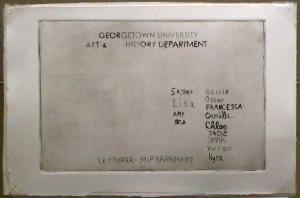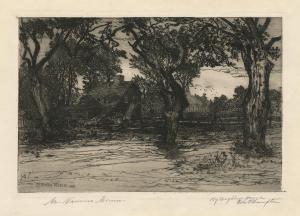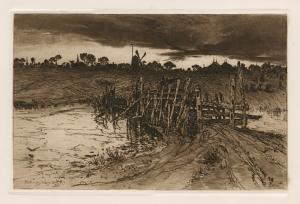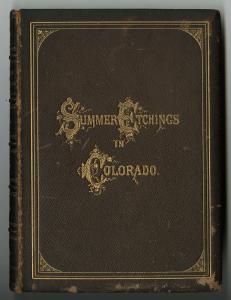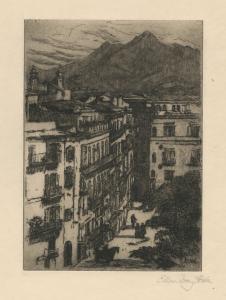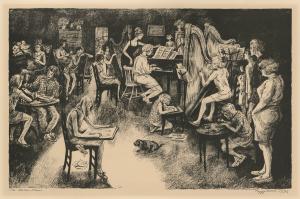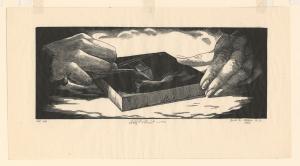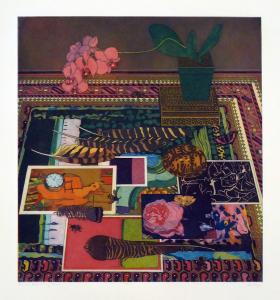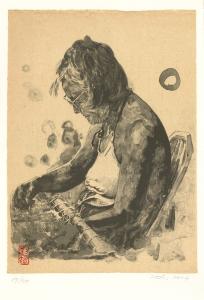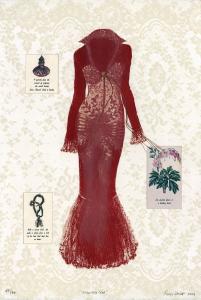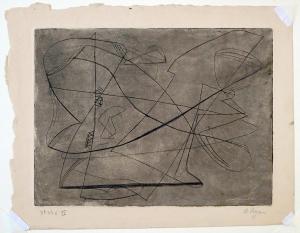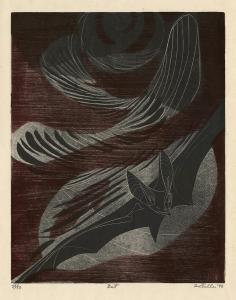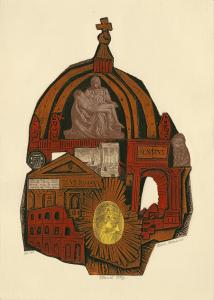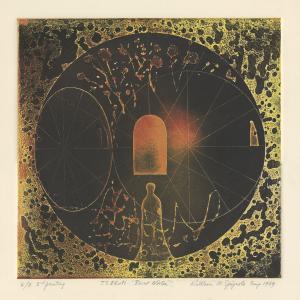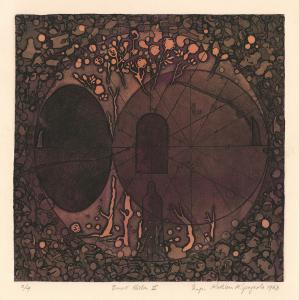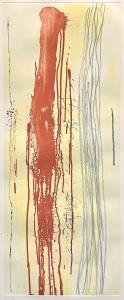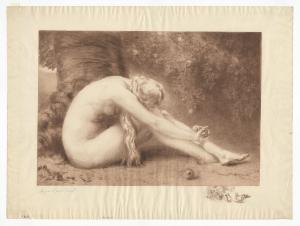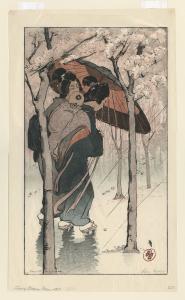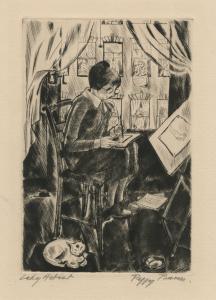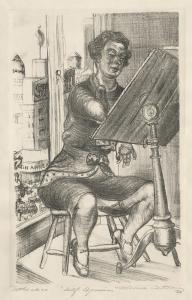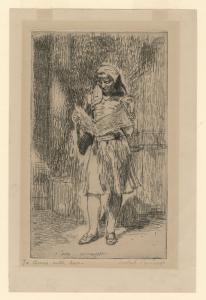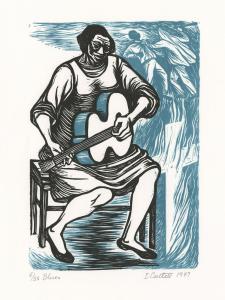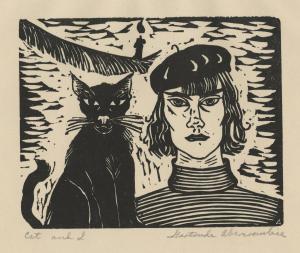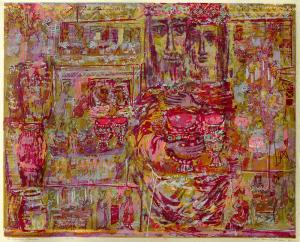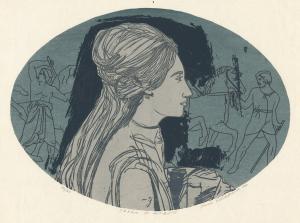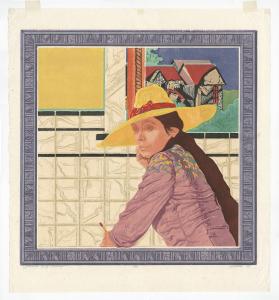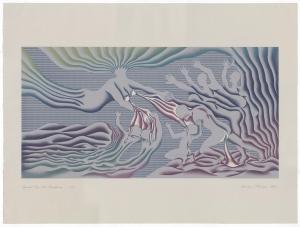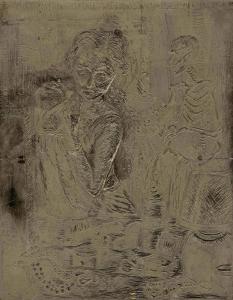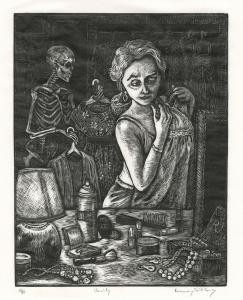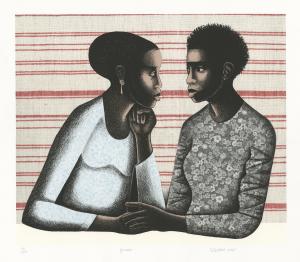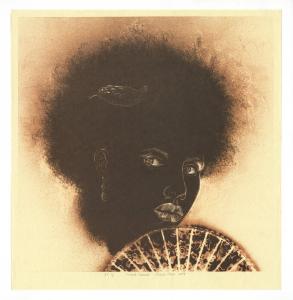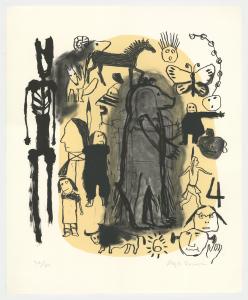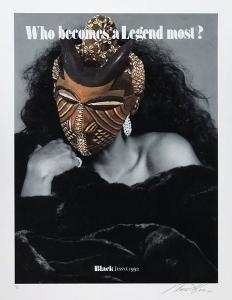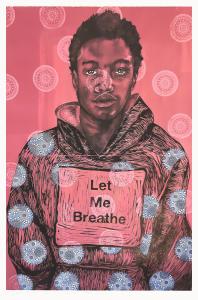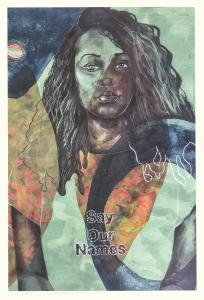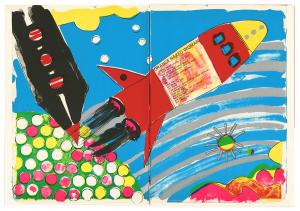American Women Printmakers
POWER UP: American Women Printmakers strives to honor the achievements of women artists within the field of printmaking. Historically, women artists encountered institutional barriers to success in the fine arts, including a lack of access to formal training, exhibitions, and sales. The rise of fine art printmaking in the mid-nineteenth century, together with new educational opportunities to train in the laborious and highly technical printmaking process, allowed women to master the medium and gain recognition and income from their artworks.
The achievements of female printmakers date back to the emergence of prints as a fine art during the American Etching Revival of the 1880s. Since that time, the printmakers in this exhibition have expanded the genre through remarkable displays of technique and through the creation of new printmaking studios. Their legacy as teachers to the next generation ensures the continuing power of printmaking. POWER UP divides the work of these printmakers into five themes that tell this story: Identity and Politics; Women Representing Women; Women and the Art Market; Support: The Importance of Studios, Teachers, and Mentors; and the Labor of Printmaking.
This exhibition was curated by the students of AMUS-508 in the Spring of 2022 (see acknowledgments at end).
The Labor of Printmaking
"We are doing an age-old thing in new media."
— Corita, from her 1968 essay “Art and Beauty in the Life of the Sister”
Printmaking encapsulates many forms of labor: carving, scratching, inking, soaking, and pressing to achieve the many printmaking techniques, including lithography, woodcut, etching, and screenprinting. In every technique, the printmaker creates an image on a plate and transfers that image onto another surface. Instead of mediums like sculpture or painting where only one product is made, printmaking produces multiple copies. Artists are able to generate income through multiple sales. Paradoxically, the time and process involved in creating the plate are left unseen in the final product. The prints included in this case represent the labor of printmaking in a number of ways. They represent some of the most laborious and intricate techniques in printmaking (wood engraving, multi-plate aquatint, soft-ground etching and spitbite) as well as the tension between printmaking as an intellectual fine art and a hand-wrought craft.
The Etching Process
In order to create an etching, the artist uses a tool called a burin to scratch through an acid resistant ground that has been applied to a copper or zinc plate. The plate is then placed in acid and the exposed design is bitten into the metal surface. Once the plate has been cleaned, ink is applied, and it is pressed onto a wet sheet of paper to create the impression. Students in Curating American Women Printmakers learned this process first hand from Professor Scip Barnhart when they visited his printmaking studio in the Walsh Building last spring. We are grateful to Professor Barnhart for sharing his knowledge and expertise and guiding us through the process of creating an etching from start to finish. The plate and print above are the product of that exercise.
My Neighbor's House, Easthampton
Mary Nimmo Moran (1842 – 1899)
Etching on paper
1883
Fairchild Endowment Fund purchase, 2020
2020.7.1
An overgrown gabled house surrounded by dense foliage is the focal point in this haunting and intricate etching. In contrast to the dark, gnarled trees in the middleground, Mary Nimmo Moran restricted her use of ink to depict the sky and ground. She created this print outside by drawing directly onto the copper plate, enhancing the atmosphere and tonal values. Moran was probably the most prominent female artist of the American etching revival in the 1880s. However, to gain acceptance into the male-dominated art world, she would often conceal her gender by signing her work with only her first initial.
’Tween the Gloaming and the Mirk
Mary Nimmo Moran (1842 – 1899)
Etching with roulette on paper
1883
Fairchild Endowment Fund Purchase, 2021
2021.13.1
With the bold shadows and vigorous, sketch-like feel of the etched lines of prints like 'Tween the Gloaming and the Mirk, Mary Nimmo Moran was widely hailed as one of the best practitioners of the Etching Revival in America. While admiring critics attributed her style to a masculine “restlessness,” her brisk, frenetic etching also demonstrated the personal, expressive quality that aligned printmaking with fine arts such as painting.
Ophelia and Summer Etchings in Colorado
Ophelia from The American Art Review
Anna Lea Merritt, artist (1844 – 1930)
Sylvester Rosa Koehler, publisher (1837 – 1900)
Etching on paper
ca. 1880
1111.1.3634
Summer Etchings in Colorado
Eliza Greatorex (1819-1897)
New York: G. P. Putnam’s Sons, 1873
Fairchild Endowment Fund purchase, 2021
2021.14.1
The Etching Revival was an international movement that promoted etching as a means of creating original, fine art prints rather than mass-produced reproductions of existing artwork. Its popularity in America in the late nineteenth century coincided with the establishment of vocational schools for women, which taught printmaking. As a result, etching became a socially acceptable pursuit for thousands of women; indeed, the first American exhibition devoted solely to women artists was The Women Etchers of America (1887), curated by Sylvester Rosa Koehler. Koehler also helped promote the Etching Revival through his journal, The American Art Review. The issue shown here includes etchings by both Anna Lea Merritt and Eliza Greatorex, the first American woman fine art printmaker. Greatorex also reproduced her prints in several travelogues she authored, including Summer Etchings in Colorado.
Street in Palermo
Ellen Day Hale (1855 – 1940)
Etching on paper
ca. 1922
1987.6.6
Ellen Day Hale was from a prominent family of artists, writers, and clergymen in Boston who supported her in pursuing an art career at home and abroad. She enjoyed unusual professional recognition, exhibiting in major international exhibitions and publishing a book on the history of art. Hale’s personal life was also unconventional. She spent the majority of her adult life with fellow artist Gabrielle De Veaux Clements, with whom she had a home in Gloucester. Hale and Clements played an important role in teaching and mentoring a younger generation of women printmakers.
Life Class
Aline Fruhauf (1907 – 1978)
Lithograph on paper
ed. 5
1931
Art Collection Purchase, 1996
1996.5.2
Life drawing classes are an essential way to learn how to draw the human body. Women were systematically barred from this artistic training until the late nineteenth century. Aline Fruhauf’s Life Class shows women in this educational setting, learning to paint the female nude figure. Female printmakers, like Fruhauf, were able to address feminine concerns while maintaining respect from their peers by presenting commentary with exceptional technical skill. This lithograph, made at the Art Students League, offers context to an unfamiliar setting, reversing gender roles in a clever and practical manner.
Chosen Few
Peggy Bacon (1895 – 1987)
Lithograph on paper
1972
Art Collection purchase, 1980
1980.1.2
Peggy Bacon, a painter and illustrator, is best known for her caricatures and satirical depictions of daily life in New York. Although trained as a painter, Bacon took an interest in printmaking and taught herself drypoint etching before she began publishing her work in magazines, such as Vanity Fair and The New Yorker. Chosen Few depicts a large gathering of women and children engaged in activities such as sketching, playing music, and reading. Like most of Bacon’s other work, this piece has a theatrical flair, with action filling the room throughout.
Self Portrait
Grace Arnold Albee (1890 – 1985)
Wood engraving on paper
ed. 40
1966
Gift of James W. Elder
1988.37.10
This self-portrait reflects the hands of artist Grace Albee at work. It is symbolic of her long and storied career. The engraved hands emphasize the strength required to carve the dense end-grain of the wood block in contrast to the skill required to achieve delicate detail. Albee won numerous awards throughout her long career and worked well into her nineties.
Cranberrying, Marble Quarrying, Codfishing
Wedgwood, manufacturer (est. 1759)
Clare Leighton, artist (1898 – 1989)
Ceramic
1952
Gift of Bob Stana in memory of Reverend Joseph A. Haller, S.J.
2015.38.2
In 1952, Wedgewood ceramics commissioned British-American artist Clare Leighton to create a series of twelve wood engravings to be printed on a limited edition set of plates. Each engraving depicts a seasonal industry for which New England was famous, including cod fishing, farming, shipbuilding, cranberrying, marble quarrying, tobacco growing, logging, and ice cutting. Typical of Leighton’s work, she used bold lines and rich tones of black and white to illustrate the ice workers, their equipment, and the surrounding landscape with dignity and respect.
Painting on china had been an acceptable amateur and professional pursuit for women from the nineteenth century into the early twentieth because it involved craftsmanship and produced objects for the home. With this plate commission, Leighton builds on the tradition of women in the decorative arts, but expands on it by employing a printmaking technique (wood engraving) historically associated with male artisans working in book and magazine illustration.
In an Adjoining Room
Katja Oxman (b. 1942)
Etching on paper
1998
Gift of the artist on behalf of the Washington Print Club
1111.1.4195
In an Adjoining Room exemplifies Katja Oxman’s command of one of the most difficult printing techniques. Through her use of multi-plate aquatint etching, she skillfully presents an array of objects selected from museum collections in an elegant still-life composition. The assortment of items appear atop a complexly patterned rug, furnishing a captivating interior universe. The compressed space evoking one dimension is reminiscent of Japanese woodblock prints that largely inspire the spectacular technical achievement of her work. The print was featured on the winter 1998-99 cover of The Washington Print Club Newsletter.
Web
Yuriko Yamaguchi (b. 1948)
Lithograph on pigmented Torinoko paper
ed. 7
2001
Gift of Carol Harrison
2016.27.186
Color printmaking is a complex process requiring multiple impressions, one per color. Here Yuriko Yamaguchi – primarily known as a sculptor – finds a clever solution, rubbing Japanese paper with pearlescent ochre pigment over which she prints a black wire-like armature, or web. The lines are twisted in layers, creating the illusion of three-dimensions. Printmaking, as the shimmering and mysterious Web seems to suggest, is ultimately an art of estrangement: created in stages, printed sequentially and in reverse, it veils and displaces artistic labor.
Needlework
from the Corcoran 2005 Print Portfolio: Drawn to Representation
Hung Liu (1948 – 2021)
Lithograph on paper with chine collé
49/70
2004
Fairchild Endowment Fund purchase, 2010
2010.22.1.11
Hung Liu is best known for her painting, particularly on the subject of work, but she was a prolific and inventive printmaker as well. In lithography, the artist draws or paints a greasy medium on the surface of a prepared stone. This technique allowed Liu to maintain her signature painterly style: the soft, brushy composition of the old woman’s body, the bubbling Buddhist-inspired circles, and even the illusion that the ink is dripping slightly, like paint.
Seduction Coat
from the Corcoran 2005 Print Portfolio: Drawn to Representation
Renée Stout (b. 1958)
Chine collé appliqué of Kitakata paper and collage on Rives BFK paper
49/70
2005
Fairchild Endowment Fund purchase, 2010
2010.22.1.21
While Renée Stout is best known for “assemblage” sculptures, which are like three-dimensional collages, Seduction Coat is an example of her work in two dimensions. Even so, Stout composed this piece in multiple layers. She first printed the patterned floral background before printing the titular coat. After printing the coat, the artist dusted it with metallic pigment, sewed a frayed string to the bodice, and applied a foil stamp as a clasp. To complete the piece, she surrounded the coat with three digital prints, each representing an element of desire.
Mayday
Louisiana Bendolph, artist (b. 1960)
Paulson Fontaine Press, publisher (est. 1997)
Aquatint, spitbite aquatint and softground etching on paper
9/50
2005
Gift of Bernard A. Mercer and Jay L. Friedenberg
1111.125.1
Louisiana Bendolph is a quiltmaker who was born in Gee’s Bend, Alabama. The women of Gee’s Bend have been making colorful, abstract quilts for six generations. Bendolph’s print is part of a series based on her quilts designs. She capitalizes on the soft, mottled surface of spitbite and aquatint to mimic the texture of cloth, and uses clear contour lines to replicate the hard-edged fabric blocks.
Support: The Importance of Studios, Teachers, and Mentors
"The fault lies not in our stars, our hormones, our menstrual cycles, or our empty internal spaces, but in our institutions and our education."
— Linda Nochlin, from her 1971 essay “Why Have There Been No Great Women Artists?”
Printmaking studios, schools, and institutions were critical entry points into the printmaking field for women during the postwar era, although they faced many challenges in receiving fair recognition in the male-dominated art world. Stanley William Hayter’s avant-garde printmaking studio, Atelier 17, which operated in New York City between 1940 and 1955, provided women with an equal opportunity to experiment and develop their printmaking skills, collaborate and support one another, exhibit their work in group shows, and advance their careers. As women developed significant expertise in printmaking, many of them started teaching. In the late 1950s, women began opening their own printmaking workshops, including Tamarind Institute (1960), Crown Point Press (1962), and Universal Limited Art Editions (1957). The founders of these workshops continued to emphasize the importance of experimentation, support, and collaboration and focused on reviving and expanding the printmaking medium. These long-established workshops are still operating today and have inspired a new generation of American women printmakers.
Beach Neighborhood
Worden Day (1916 – 1986)
Lithograph on paper
ca. 1935
Fairchild Endowment Fund purchase, 2022
2022.1.1
Worden Day studied with several established instructors in New York and at the Art Students League, becoming skilled in a variety of printmaking techniques. This lithograph from early in her career may have some connection with the Depression era’s Federal Art Project. During this time Day supervised a workshop established by the Works Progress Administration to print reading books for children in New York City’s public schools. The books were printed on an offset lithographic press. The artist later studied with Stanley William Hayter at Atelier 17 where she enjoyed the opportunity to refine her abilities in various techniques including intaglio and woodcut. She went on to become an influential art instructor at a number of universities.
Untitled [Abstraction]
Anne Ryan (1889 – 1954)
Etching on paper
1943
Art Collection purchase, 2016
2016.47.2
Created while she was a student at Atelier 17, this etching by Anne Ryan plays with texture by contrasting soft, deftly curved lines with thicker, straighter cuts. Ryan’s work takes inspiration from the acclaimed abstract prints of Atelier 17’s founder, Stanley William Hayter, who offered Ryan a partial scholarship to attend the print studio when she was fifty-two. Despite clear similarities with Hayter’s techniques, Ryan’s work received sexist reviews, with one Art News writer criticizing the printmaker’s “delicate etchings” as “sensitive and essentially feminine.”
Bat
Sue Fuller (1914 – 2006)
Engraving with soft-ground etching on paper
ed. 50
1946
Art Collection purchase, 2016
2016.47.1
Sue Fuller experimented with many techniques at the Atelier 17 studio. Here she used soft-ground etching, a process whereby a material such as fabric is pressed onto a soft coating on the plate leaving an impression. The plate is then placed in an acid bath, etching the weave of the fabric. In Fuller’s Bat, finely etched lines form a coarse brown and blue pattern, each color printed separately. The smooth, black bat enhances the work’s textural landscape.
Descent
Perle Fine (1908 – 1988)
Robert Blackburn, printer (1920-2003)
Lithograph on paper
ed. 12
1950
Gift of Jay L. Friedenberg
2016.17.1
Descent is a rhythmic composition of powerful lines, geometric curves, and abstract shapes created by Perle Fine to explore her unconscious emotions. This lithograph was printed by Robert Blackburn, a master printer who taught prominent abstract expressionist painters, including Grace Hartigan and Helen Frankenthaler. Fine’s early experiences with lithography, as well as line engraving and soft-ground etching at Atelier 17 significantly influenced the development of her technique.
Tenth Memory
June Wayne (1918 – 2011)
Lithograph on paper
Trial proof, inscribed to Prentiss Taylor
ed. 25
1961
Gift of Roderick Quiroz
1997.19.1
Tenth Memory is profoundly entangled with June Wayne’s role as founder of the Tamarind Lithography Workshop in Los Angeles in 1960, where she dedicated herself to the revival of lithography. As a part of her commitment to educate artists and printers so as to ensure the survival of the technique, Wayne made use of the workshop to create prints that ultimately show the types of effects only possible with lithography. The hazy characteristic of Tenth Memory afforded by lithographic techniques acutely conveys the artist’s vision of the disintegration of memories and fundamentally, the merit of lithography itself.
Who will Accept our Offering at this End of Autumn?
from the series The Archaics
Grace Hartigan (1922 – 2008)
Universal Limited Art Editions, publisher (est. 1957)
Lithograph on paper
Artist’s proof
1962-1966
Gift of Jay L. Friedenberg
2019.6.1
Who Will Accept Our Offering at This End of Autumn? is part of Grace Hartigan’s The Archaics, a series of lithographs inspired by the poems of Barbara Guest. This striking image, printed in vivid black ink, has a gestural appearance and reflects the melancholy imagery evoked in the poem. The series was completed in 1966 at Universal Limited Art Editions, a printmaking workshop founded by Tatyana Grosman. Grosman first encouraged Hartigan to make lithographs in 1959 by giving her lithographic limestones to experiment with creating images on the stone’s surface.
Innerview
Louise Nevelson, artist (1899 – 1988)
Hollander Workshop, Inc., publisher (est. 1964)
Lithograph with collage on paper
ed. 15
1965
Gift of Jay L. Friedenberg
2016.17.2
Acclaimed sculptor Louise Nevelson is known for her large-scale installations and nested wood constructions in monochromatic tones. In the early 1960s, she earned a six week fellowship at June Wayne’s Tamarind Institute of lithography in Los Angeles. There she created twenty-six technically innovative editions and worked alongside master printer Irwin Hollander. When he left to establish his own studio in New York, Nevelson continued working there a few years later. Innerview, created at Hollander’s workshop, has an overlapping collaged layer that mirrors the drawing underneath, establishing a three dimensional dynamic evocative of the artist’s work in wood.
Eternal City II
from the portfolio Ten Prints by Ten Printmakers
Clare Camille Romano, artist (b. 1922)
Pratt Graphic Art Center, publisher (1953 – 1985)
Collagraph/Collograph with etching on paper
18/100
1968
Art Collection purchase, 1993
1993.7.14.8
Eternal City II was printed at The Pratt Graphic Art Center, a fine art print studio co-founded at Pratt Institute in New York City by art professor Fritz Eichenberg and printmaker Margaret Lowengrund. The Center provided workshop space along with exhibitions, instruction, and master printing, and was an important source of support and mentorship for two generations of printmakers.
Burnt Norton and Burnt Norton II
Kathleen Spagnolo, artist (1919 – 2016)
Burnt Norton
Etching with multi-level viscosity printing on paper
6/8 (second printing)
1969
Gift of the Estate of Kathleen Spagnolo
2016.15.25
Burnt Norton II
Etching with multi-level viscosity printing on paper
3/4
1968
Gift of the Estate of Kathleen Spagnolo
2016.15.26
Named after the ethereal poem by T.S. Eliot, Spagnolo’s Burnt Norton series evokes the psychedelic and transcendental. The artist achieves this vibrant polychromatic effect through multi-level viscosity printing, a technique developed at Atelier 17. The process allows artists to print with different colors simultaneously, utilizing a layered matrix and inks of various consistencies. Born in Britain but later based in Alexandria, VA, Spagnolo garnered increased recognition after being featured in the 2016 exhibition Undiscovered Printmakers: Hidden Treasures at Georgetown University Library.
Untitled [Red and black]
from the Lunar Series
Dorothy Dehner, artist (1901 – 1994)
Tamarind Lithography Workshop, publisher (est. 1960)
Lithograph on paper
9/20
1971
Art Collection purchase, 1994
1994.1.1
Primarily a sculptor, Dorothy Dehner was introduced to printmaking at the Atelier 17 studio. There she met Louise Nevelson who recommended she experiment with lithographs at June Wayne’s Tamarind Lithography. Long interested in abstraction, Dehner created this deceptively simple composition of red, white, and black. At first glance, the upper half appears to mirror the lower, but the two sets of rectangles vary in size and location, creating an intriguing interplay.
The Nile
Pat Steir, artist (b. 1938)
Crown Point Press, publisher (est. 1962)
Aquatint (soap-ground and sugar-lift) with soft-ground etching and drypoint
1992
Gift of Jay L. Friedenberg
2016.17.3
In The Nile, streaks of striking reds and blues stream across a yellow field. Pat Steir conveys her gestural drips through intricate aquatint techniques involving partially dissolved soap ground as well as brushwork applied with corn syrup, a process invented by Sue Fuller at Atelier 17. This print was created at Crown Point Press, a printmaking studio and publishing company established in 1962 by Kathan Brown. The studio continues to offer workshops to this day.
Women Representing Women
"I didn’t want to be a woman artist, I just wanted to be an artist."
— Isabel Bishop in The “New Woman” Revised: Painting & Gender Politics on Fourteenth Street by Ellen Wiley Todd, 1993
Representations of women have often been defined through the lens of male artists. Female printmakers of the mid-20th century replaced the male perspective with their own. During this period, women artists had unprecedented opportunities to practice printmaking in collaborative studios, enabling them to experiment with new techniques and subject matters. Printmaking opened a powerful avenue of self-expression that allowed these artists to portray multidimensional women, as opposed to objectifying them in the traditional male gaze.
Eve (Eve Repentant)
Anna Lea Merritt (1844 – 1930)
Etching on vellum
1887
Fairchild Endowment Fund purchase, 2017
2017.32.1
Anna Lea Merritt’s artworks pushed social conventions to represent controversial topics like the nude. Eve Repentant reinterprets this iconic theme by emphasizing Eve’s perspective, showing a woman in agony, seated on the ground and covering her face as if to demonstrate true remorse for her actions. Despite posing Eve in such a way as to conceal her body, Merritt’s subject nevertheless attracted public censure for depicting Eve in the nude.
Cherry Blossom Rain
Helen Hyde (1868 – 1919)
Woodcut on paper
1905
Art Collection purchase, 1994
1111.1.3379
Cherry blossom petals fall alongside raindrops during this intimate moment of companionship between two women. One holds an umbrella aloft to shield them from the onslaught of rain and cherry blossoms, protecting the peaceful baby that sleeps on its mother’s back. Helen Hyde honors female kinship and the Japanese woodcut tradition in this artwork, a technique she studied while living in Japan from 1899 to 1914. Known for her representations of Japanese women and children, this print exemplifies Hyde’s style and subject matter.
Lady Artist
Peggy Bacon (1895 – 1987)
Drypoint on paper
1925
Gift of James W. Elder
1988.37.20
The subject of Peggy Bacon’s Lady Artist sketches by an open window. The drypoint technique and cartoon style infuse the scene with charming energy, revealing Bacon’s artistic hand through her scratchy lines. Peggy Bacon pays homage to female artists and highlights the process employed in creation of this print.
Self Expression
Minna Wright Citron (1896 – 1991)
Lithograph on paper
ed. 20
1977
Gift of James W. Elder
1988.37.51
In this self-portrait, Minna Wright Citron’s body language opposes the traditional representations of women of her time. Typically, women were expected to sit with their legs crossed and act conservatively. However, Citron’s positioning of her legs as sprawled open reveal the slip underneath her dress. Her arm rests comfortably on the easel and she is confident, even relaxed, in her pose. This honest and un-idealized representation of the artist working shows her actively engaged in her profession. By doing so, Citron is presenting herself as she saw herself, as a professional and an artist.
Girl With Newspaper
Isabel Bishop, artist (1902 – 1988)
Associated American Artists, publisher (1934 – 2000)
Etching on paper
original edition
ca. 1949
Art Collection purchase, 1978
1978.2.1
Isabel Bishop was a social-realist artist known for her paintings and prints of women in the workplace. The woman pictured is bending her arms and leaning on her left leg, merging with the energetic linework in the background and creating a sense of movement. The artist etched directly onto the copper plate, contributing to the work's liveliness and attention to the human figure. Throughout her career, Bishop documented the everyday lives and increasing independence of women in the workplace.
Blues [I Have Given the World My Songs]
Elizabeth Catlett (1915 – 2012)
Linocut on paper
5/35
1947
Art Collection purchase, 1986
1986.12.2
Elizabeth Catlett was born in 1915 in Washington, D.C. and was the granddaughter of freed slaves. She attended Howard University where she studied printmaking. Her identity as both a black person and a woman strongly influenced her work, which often revolved around civil rights and black culture. In her lithograph, from her early series I am the Negro Woman (later renamed I am the Black Woman), Catlett depicts a woman strumming a guitar surrounded by scenes of violence being inflicted upon African-Americans. Amidst all this chaos, the focal point is the woman, showing her resilience and the strength of black women, despite all the hardships they face.
Cat & I (ex Chicago Portfolio)
Gertrude Abercrombie (1909 – 1977)
Linocut on paper
ca. 1936
Gift of James W. Elder
1988.37.9
While Gertrude Abercrombie is better known for her surrealist paintings, this print from early in her career includes both of her classic subjects: cats and herself. As a magical realist, Abercrombie often featured cats, and other occult symbols, in sorcery-tinged landscapes and self-portraits. In art and in life, she cut a witch-like figure; her signature look included a long cape and a pointy hat. While the beret and striped turtleneck of this self-portrait may appear more beatnik than witchy, Abercrombie’s glowing, catlike eyes hint at the otherworldly.
This Beginning of Miracles
Corita Kent, artist (1918 – 1986)
International Graphic Arts Society, publisher (est. 1951)
Screenprint/serigraph on paper
ed. 210
1953
1984.2.64
This Beginning of Miracles likely depicts Mary with Jesus as he performs the miracle of turning water into wine at the Marriage at Cana. Corita uses the technique of color screenprinting, where multiple screens are printed on one surface, one screen per color. This print used twenty-three screens, or color separations, for the final image. Each matrix needed to be in alignment for the sheet to be covered and the composition to emerge.
Dream of Antiquity
June Mary Ann Hildebrand (b. 1930)
Linocut on paper
42/50
1966
1111.1.5766
Dream of Antiquity shows a woman in profile with a classical battle scene in the background. She is the main character against a scene that does not traditionally include women, much less portray them with strength and stature. The clear ink lines add an element of rawness to the composition. Known for her expressive linoleum or linocut prints, this is a quintessential work by June Hildebrand.
Summer Self Portrait
Sylvia Solochek Walters (b. 1938)
Woodcut on paper
9/16
1977
Gift of James W. Elder
1988.27.314
In this self-portrait, Sylvia Solochek Walters presents an image of herself centered on her identity as an artist. The portrait depicts a lively subject engaged in the act of looking and sketching. The artist’s pose empowers the female body and thus challenges the long-standing history of depicting women as objects of the male gaze in art.
Woman with Hat
Emma Amos (1938 – 2020)
Associated American Artists, publisher (1934 – 2000)
Etching on paper
29/35
ca. 1984
Art Collection purchase, 1996
1996.15.20
Although Emma Amos has recently gained praise for her half century of work as a painter and graphic artist, she struggled to find recognition and commercial sales for most of her career. The idea of being erased from history was a persistent concern for her. Here, the broad brim of the woman’s hat threatens to engulf her and the shadows around her eyes and mouth give her a world-weariness that hints at the artist’s concern with erasure.
Guided by the Goddess
from the Birth Project
Judy Chicago (b. 1939)
Screenprint/serigraph on paper
1/75
1985
Art Collection purchase, 1991
1991.14.7
Feminist icon Judy Chicago has long fought for the representation of women in the arts. Guided by the Goddess alludes to the way women have embodied creation in the myths and tales of cultures worldwide. This screenprint from Chicago’s Birth Project prominently illustrates a woman as the spiritual being who gives and sustains life to people and land.
Puppetmaker (front side) Vanity (reverse side)
Rosemary Feit Covey (b. 1954)
Wood printing block
1976 (Puppetmaker) 1988 (Vanity)
Gift of Eric Mackenzie in memory of William C. Garwood and Gwendolyn Garwood
2011.1.44
Printmaking matrices are the physical surfaces manipulated to hold ink. Wood engravings are produced by carving the hard, dense end grain of a wood block. The harder surface allows for much finer, more durable lines than can be carved on a woodblock matrix, which uses the face grain. Gray or tonal areas are created by carving fine hatch marks or patterns into the wood.
Vanity
Rosemary Feit Covey (b. 1954)
Wood engraving on paper
ed. 80
1988
Gift of Eric Mackenzie in memory of William C. Garwood and Gwendolyn Garwood
2011.1.210
In Vanity, Rosemary Covey represents herself in a domestic tableau coupled with a scene of decay. It is an allegory of caution against earthly pleasures. In the black and white print, Covey draws a parallel between the laborious process of printmaking and the maintenance of youth. Wood engravings require direct carving and careful attention to detail. The scene presents Covey bringing a similar care to her own youth and beauty. Makeup and jewelry are sprawled across the vanity as a figure of death lurks in the background.
Gossip
Elizabeth Catlett (1915 – 2012)
Brodsky Center for Innovative Editions, printer and publisher (est. 1986)
Digital print with photolithograph on paper
15/200
2005
Art Collection purchase, 2005
2005.16.1
Over the course of her seventy year career as a sculptor and graphic artist, Elizabeth Catlett focused on the experience of Black American women. Here, she presents two large and central figures who take up almost the entire composition. There is no way to ignore them, yet they pay no attention to us, focusing only on each other’s gaze. Catlett positions the Black Power fist in the center, imbuing the work with a quiet subversiveness.
Marie Laveau
Renée Stout (b. 1958)
Lithograph on paper
ed. 36
2010
Gift of the artist on behalf of the Washington Print Club
2011.9.1
Drawing from history as well as her own life experiences, Renée Stout’s work honors African Diasporic culture. Marie Laveau offers a unique depiction of the famous Louisiana Voodoo queen, who is typically portrayed as a light-skinned woman. By depicting Laveau with dark skin, Stout highlights her African heritage. Her piercing green eyes confront the viewer’s gaze, luring one in.
Identity and Politics
"Art for me must develop from a necessity within my people. It must answer a question, or wake somebody up, or give a shove in the right direction."
— Elizabeth Catlett, quoted in Elizabeth Catlett: Art for Social Justice by Klare Scarborough, 2015
For the past century, women have used printmaking to respond to social issues relating to class, race, and gender roles. The reclaiming of this medium by feminine voices challenges the historically male-dominated field of printmaking. By including themselves in the printmaking space, women were able to represent the female perspective using their own unique experiences. The prints in this section reflect the intersectionality of social identity and stand in opposition to legacies of racism and sexism in America, which has especially marginalized women of color. The ability of prints to be reproduced and circulated has made them an ideal media for political content, and printed posters have been prominent in recent protests for social justice.
Power Up [group of 4 serigraphs]
Corita, artist (1918 – 1986)
Daniel Joseph Berrigan, SJ, author (1921 – 2016)
Screenprint/serigraph on Pellon
ed. 100
ca. 1965
1111.1.6564
Power Up merges art, design aesthetics, and politics. Sister Corita (Elizabeth Kent) was an educator, activist and nun who infused her Pop Art prints with religious and overt political content absent in the work of her peers in the movement. This print, which was based on an advertisement for Richfield Oil gasoline company and a line from a sermon by Jesuit priest and anti-war activist Daniel Berrigan, continues to inspire. Most recently posters based on Power Up were carried in the 2016 Women’s March in Washington, DC.
Sticky Mouth
Jaune Quick-to-See Smith, artist (b. 1940)
Michael Sims, printer (b. 1944)
Lawrence Lithography Workshop, publisher (est. 1979)
Lithograph on paper
32/40
1997
Fairchild Endowment Fund purchase, 2011
2011.24.2
Bold colors layered on top of one another, abstract figures, and vivid representations of movement. All of these make up Jaune Quick-to-See Smith’s eye-catching pieces. Her work blends personal narratives concerning her own Salish identity with commercial images that express political commentary about Native Americans. Here a bear (“sticky mouth” in Blackfoot) is surrounded by images resembling Native American pictographs and Plains hide paintings.
Blackglam Legends: Black Jessye 1992
from the African Diva Project
Margaret Rose Vendryes (1955 – 2022)
Archival pigment print on paper
2/5
2019 (incorporating a 1992 photograph likely by Rocco Laspata)
Fairchild Endowment Fund purchase, 2020
2020.3.1
In Who Becomes a Legend Most, Margaret Rose Vendryes gives the Blackglama mink ad campaign a new meaning. Adding traditional African face masks to the models, she reconnects them to their African roots. Her alteration of the brand’s slogan brings viewer’s attention to the irony of the ad, asking them to question the use of Black models to sell black mink.
Mom in Harlem
Judy Bowman (b. 1952)
Archival pigment print on paper
ed. 25
2020
Fairchild Endowment Fund purchase, 2020
2020.2.1
While a student majoring in art at Morris Brown College and Clark Atlanta University, Judy Bowman was selected to contribute to the decoration of the Martin Luther King, Jr. Library at the Interdenominational Theological Center. During that time she was privileged to meet Dr. King’s wife Coretta and his mother Alberta, which had a formative impact on her career. Mom in Harlem is a reflection on Bowman’s childhood and stories of her mother.
Let Me Breathe and Say Our Names
Delita Martin (b. 1972)
Let Me Breathe
from the Art for Activism series
Archival pigment print on paper
20/100
2020
Fairchild Endowment Fund Purchase, 2020
2020.25.1
Say Our Names
from the Art for Activism series
Archival pigment print on paper
19/100
2020
Fairchild Endowment Fund Purchase, 2020
2020.25.2
Let Me Breathe and Say Our Names are powerful calls to action in the name of social justice. Made in response to the murder of George Floyd, these prints draw attention to the issues of police brutality and racial oppression in America. After Delita Martin’s original drawings of her son and niece were shared on social media, the response was so great that she decided to create a print edition to address social justice concerns. From the proceeds of the sales she set up a fund to support struggling artists engaged in visionary projects within their communities.
Women and the Art Market
Pages 40-41
from the portfolio One Cent Life
Kiki Kogelnik, artist (1935 – 1997)
Walasse Ting, author (1929 – 2010)
Lithograph on paper
529/2000
1964
Art Collection purchase, 1990
1990.24.2.0
Although access to art education has dramatically improved for women over the past century, the art market remains a persistent site of inequality. This vibrant print by Kiki Kogelnik is part of the One Cent Life portfolio. Twenty-eight artists participated in One Cent Life, including three women. This Kogelnik print sold in 2017 for $300. In contrast, Mel Ramos’ print Tiger Girl from One Cent Life sold in 2019 for $625 and Andy Warhol’s Marilyn Monroe, I love your Kiss Forever is currently priced at $2,200. According to a recent international survey of auction results, women artists’ work sells for 47% less than men’s. Overall, artwork by women makes up only 2% of worldwide auction sales and 11% of new museum acquisitions.
Guest Curated by the Students of AMUS-508, Spring 2022:
Chloe Akazawa, Beatriz Areizaga, Kennedy Brooks, Sadie Butler, Skyler Coffey, Francesca Donovan, Oscar Flores-Montero, Olivia Giampietro, Sosse Krikorian, Emma McMorran, Naren Rajani, Kyra Resnicow, Emma Trone, Camille Williams, and Amy Zavecz.
Course Instructors:
Professor Lisa M. Strong, Director, Art and Museum Studies
Art Curator LuLen Walker, Booth Family Center for Special Collections
Assistant Art Curator Christen Runge, Booth Family Center for Special Collections
Online exhibition assembled by Maeve Silk (COL '23).

